Artificial intelligence-based opportunity insights
Pega Sales Automation uses decisioning capabilities to provide predictive
insights for opportunities. Opportunity insights are displayed in the opportunity record for each opportunity. The
Opportunity insights widget is dynamic and responds to changes, such as stage changes
and changes in customer activity or contact growth. Pega Sales Automation uses separate strategies for business and individual
opportunities. The strategies are used to drive the insights that are displayed as
opportunity AI Insights and they are used to take periodic predictor snapshots. The strategy (B2B or B2C) runs all three model types (move to next stage, opportunity
win, and win date), distinguishing them by using labels that are mapped to the issue and
group hierarchy. For the opportunity win and move to next stage models, the strategy
also evaluates a model without predictors (opportunity win base propensities) to
establish a base propensity for benchmarking. Pega Sales Automation uses self-learning adaptive models to generate
opportunity predictions. This approach is based on core decision management capabilities and
provides the flexibility to add and remove predictors as your needs change. The following tables include the predictors provided in
the adaptive model for Pega Sales Automation and Pega Sales Automation for
Financial Services: Review the following adaptive models architecture concepts: Adaptive models predict the likelihood that an opportunity will move
from the current stage to the next stage. Pega Sales Automation uses the average number of all
opportunities that have moved from the current stage to the next
stage as the base propensity. The difference between the likelihood
that an opportunity will move and the base propensity is an
indicator of how you are progressing with the opportunity. Adaptive models predict the likelihood of winning an opportunity. Pega Sales Automation uses the average number of all won
opportunities for a given stage as the base propensity. The
difference between the likelihood that you will win an opportunity
and the base propensity is an indicator of how you are progressing
with the opportunity. Adaptive models predict the quarter (for B2B) or the days (0-60, for
B2C) when an opportunity is most likely to close. Pega Sales Automation compares the target date range that
is set by the sales representative and the predicted closing
quarter/days to indicate whether the opportunity close date is
earlier than expected, on time, or delayed. Prediction for this model is: will this opportunity ever be won? The
input predictor range should be as complete as possible. B2B and B2C
opportunities have different predictors. This model does not use predictors. Instead, the model uses an
opportunity stage as the context to provide the base propensity of
winning an opportunity in the current stage. Prediction for this model is: will this opportunity ever move to a higher
stage? When an opportunity moves from the current stage to the next
stage, the application sends a positive, one-response to all
opportunities in the Adaptive Decision Manager (ADM) data cache. Pega Sales Automation also takes a snapshot of the previous
stage. The response is filtered by using an additional Decision Data
Store (DDS) data set. The response strategy for the move to the next
stage model filters out the decision results for stages that have
already been marked as positive. It then determines whether the current
stage is higher than the stage in the snapshot and returns only the
decision results for which this is true. B2B and B2C opportunity have different predictors. This model does not use predictors. Instead, the model uses an
opportunity stage as the context to provide the base propensity of
moving from the current stage to the next stage. This data model supports separate models for the following outcomes: Pega Sales Automation uses propositions (different for B2B and
B2C opportunities) in a Decision Data shape to model the date ranges.
The propositions have both a minimum and maximum days attribute. If you
require more granularity, you can edit the propositions to meet your
needs and to create a smoother display for the dashboard widget. This model does not use predictors. Instead, the model uses an
opportunity stage as the context to provide the base propensity of
winning an opportunity in a specified time frame. Opportunity insights use the D_PredictSAOpportunity data
page. The Analytics
widgets in the opportunity run in the context of the
D_PredictSAOpportunity data page. This data
page has the SAPredictOpportunity activity as a
data source, which runs the SAPredictOpportunity
data flow. The data flow fetches the precalculated predictors using a
data set. The data flow sets the predictors on opportunity case and uses
the EvaluateOpportunity strategy of B2B/B2C
opportunity to predict the propensity to move to the next stage, to win
an opportunity, and to predict the close date quarter. This data page
populates the propensity for an Opportunity case. Analytics widgets of
the opportunity insights run in the context of the
D_PredictSAOpportunity data page. This data
page has the SAPredictOpportunity activity as a
data source, which runs the PopulatePredictors
activity. The PopulatePredictors activity replaces
the following activities: GetContactGrothRatio,
GetEmailActivityRatio,
GetTrendsDataRatio, and
GetCIRatio, which are available in the Pega Sales Automation application. When there are multiple
products specified, the PopulatePredictors activity
iterates all of the products propensity, but displays the least
propensity model. This workflow is applicable only for the credit and
debit product types. The solution uses the StoreOpportunitySnapshots data
flow during the initial training of the models by using the business
opportunity data that is fetched from the internal production data. This
data flow converts each record from the
PegaCRM-Data-SFA-Predictors class into
opportunity objects and then routes them to the
EvaluateOpportunity strategy. In the data flow,
the mode for the EvaluateOpportunity strategy is
set to Make decision and store data for later response capture. The input for TrainFromHistory comes from the
RD OpportunityStages, which fetches one record
per business opportunity from the predictors’ data table, sorted by
maximum stage. This data flow calls the
OpportunityClosed and
MovedToNextStage data flows. The OpportunityClosed data flow calls the
CloseOpportunity strategy, which captures
responses for decisions in the past period. The MoveToNextStage data flow calls the
HandleNextStageResponses strategy, which is the
core strategy for training the
PredictNextStageModels adaptive model. The
available responses depend on whether an opportunity moves up or down
from the current stage. The SnapshotOneOpportunity data flow reuses the
EvaluateOpportunity strategy, which is used to
train the model during bulk processing. This data flow runs on a daily
basis and captures all predictors for the opportunity each time it
runs. The SAPredictOpportunity data flow reuses the
EvaluateOpportunity strategy to get the
analytic results for the opportunity. To view the details for each data flow, perform the following steps: The following are the opportunity insights strategies: To view the details of each strategy, perform the following steps: Each adaptive model has predictors, context, and outcomes that you must configure
before you can train the models to predict outcome propensities based on your use
cases. Base propensity models do not have any predictors, but they have the
OpportunityStage property in their context so you can train
different models for each stage. Outcome propensities are configured for the following models: To view the details of each model, perform the following steps: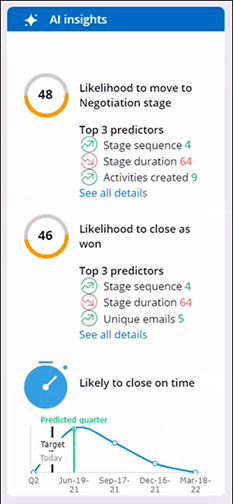
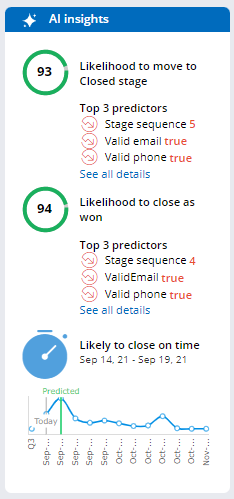
Opportunity insights workflow overview
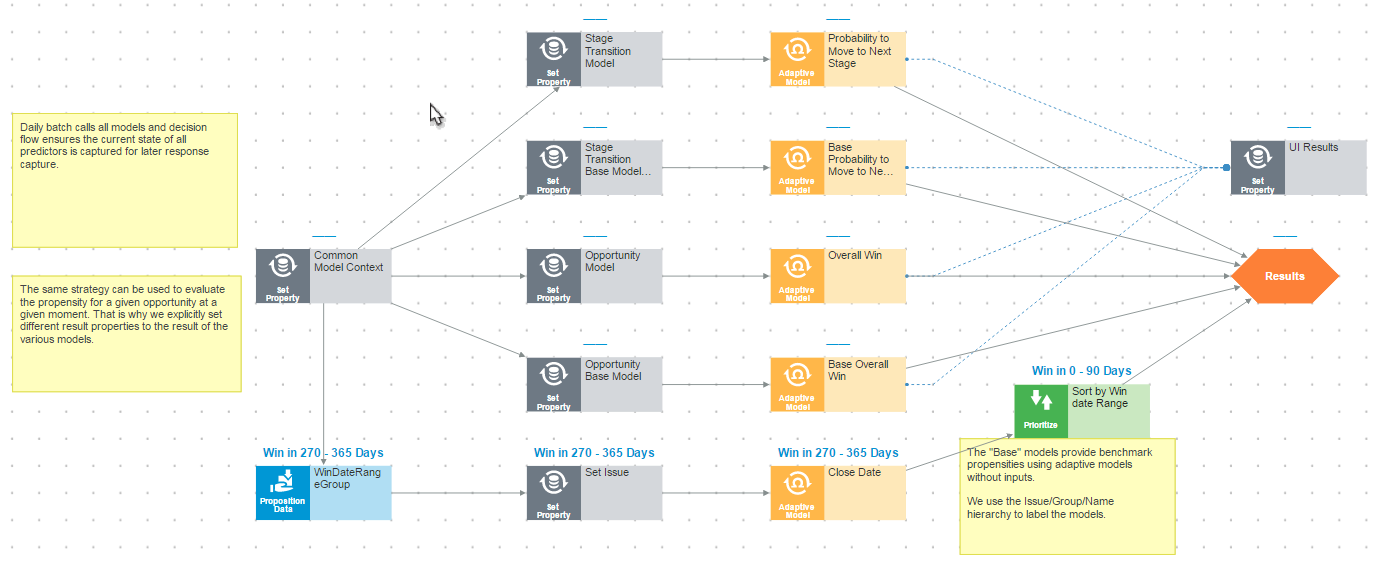

Historical data and adaptive learning
Pega Sales Automation adaptive model predictors
B2B opportunity B2C opportunity StageDuration StageDuration ActiveDays ActiveDays OpportunitySource OpportunitySource ContactGrowthPast30Vs90Days PrimaryContact - Age ReceivedUnique30Vs90 PrimaryContact - Gender ReceivedTotal30Vs90 PrimaryContact - Marital status SentUnique30Vs90 PrimaryContact - HouseholdMemberRole SentTotal30Vs90 PrimaryContact - ValidPhone AllUnique30Vs90 PrimaryContact - ValidEmail AllTotal30Vs90 CountOfCIsPast30Vs90Days CountOfCIsPast30Vs90Days StageSequence OrgDownloadActivity30Vs90Days SalesType OrgSubscribeActivity30Vs90Days OrgWebsiteActivity30Vs90Days OrganizationIndustry OrganizationRevenue StageSequence SalesType Pega Sales Automation for Financial Services adaptive model
predictors
B2B opportunity B2C opportunity ActiveDays ActiveDays AllTotal30Vs90 Age (months or years in business) AllUnique30Vs90 AllTotal30Vs90 AnnualRevenue AllUnique30Vs90 ContactGrowthPast30Vs90Days AnnualIncome CountOfClsPast30Vs90Days ContactGrowthPast30Vs90Days CurrentAssets CountOfClsPast30Vs90Days EstimatedCreditScore CurrentAssets LoanAmount EstimatedCreditScore MonthlyDebtToIncomeRatio LoanAmount MonthsInBusiness MonthlyDebtToIncomeRatio NumberOfEmployees NoOfAccounts OpportunitySource NoOfHouseholdMembers OrganizationIndustry OpportunitySource OrgDownloadActivity30Vs90Days pyPostalCode OrgSubscribeActivity30Vs90Days ReceivedTotal30Vs90 OrgWebsiteActivity30Vs90Days ReceivedUnique30Vs90 PreviousYearGrowth SentTotal30Vs90 pyPostalCode SentUnique30Vs90 ReceivedTotal30Vs90 StageDuration ReceivedUnique30Vs90 StageSequence SentTotal30Vs90 TotalOutstandingDebt SentUnique30Vs90 ValueOfCollateral StageDuration StageSequence TotalOutstandingDebt ValueOfCollateral Opportunity insights architecture
Predictors
Strategy models

Win date model outcomes
B2B opportunity B2C opportunity Will this opportunity be won in 0-90 days from
now? Will this opportunity be won in 0-5 days from
now? Will this opportunity be won in 90-180 days from
now? Will this opportunity be won in 5-10 days from
now? Will this opportunity be won in 180-270 days from
now? Will this opportunity be won in 10-15 days from
now? Will this opportunity be won in 270-360 days from
now? Will this opportunity be won in 15-20 days from
now? Will this opportunity be won in 20-25 days from
now? Will this opportunity be won in 25-30 days from
now? Will this opportunity be won in 30-35 days from
now? Will this opportunity be won in 35-40 days from
now? Will this opportunity be won in 40-45 days from
now? Will this opportunity be won in 45-50 days from
now? Will this opportunity be won in 50-55 days from
now? Will this opportunity be won in 55-60 days from
now? 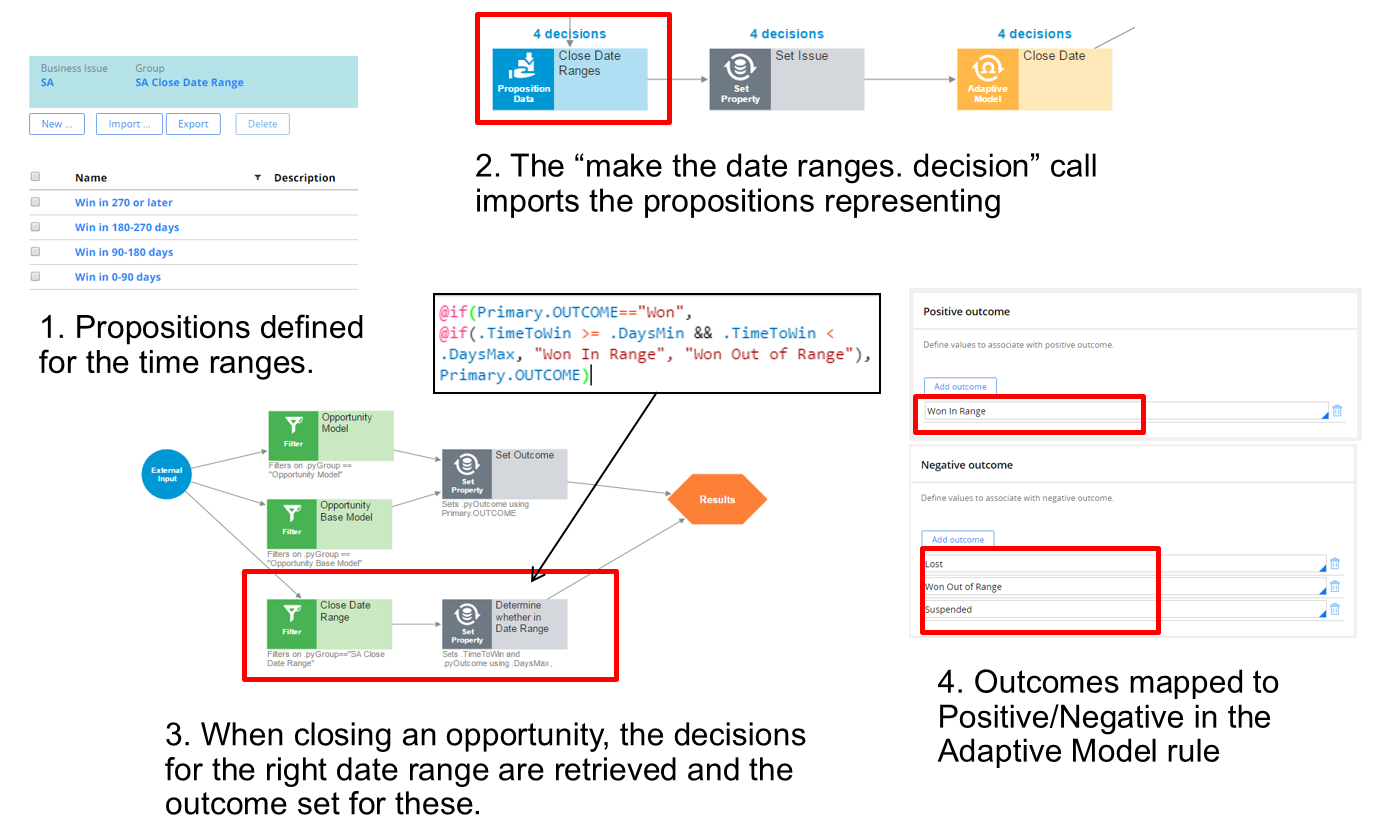
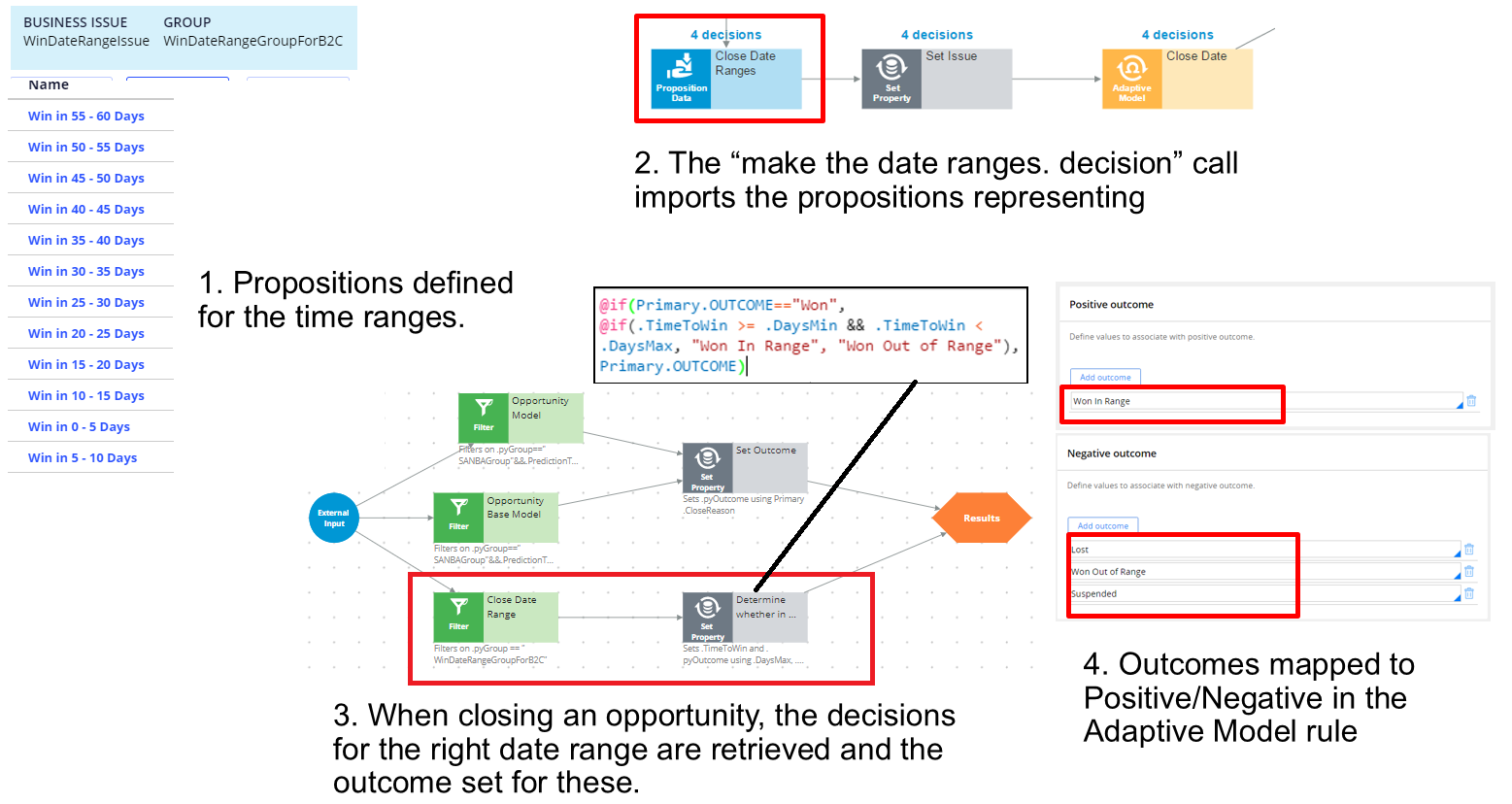
Data pages
Data flows
Strategies
Adaptive models
Previous topic Voice AI model training Next topic Artificial intelligence-based sales coach
